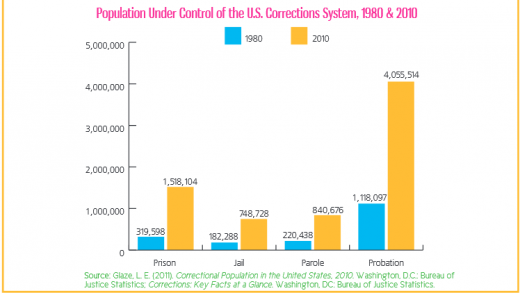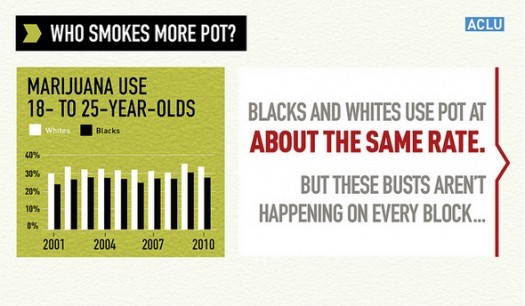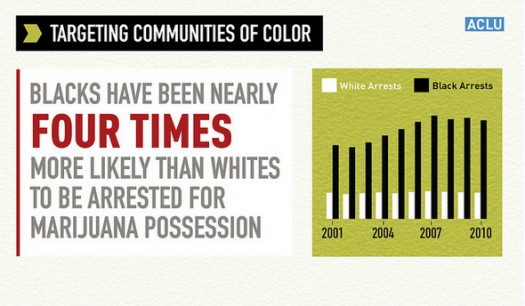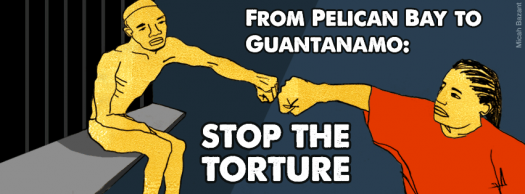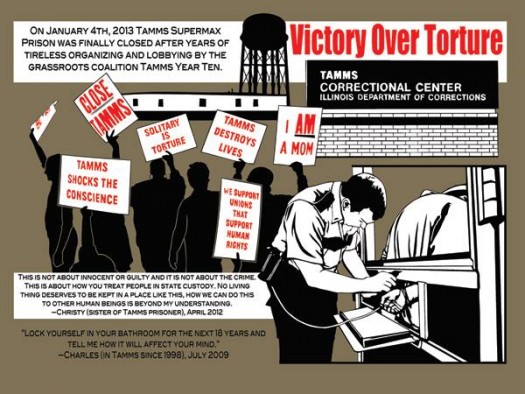15 Things That We Re-Learned About the Prison Industrial Complex in 2013
The engine of the prison industrial complex unfortunately kept on chugging in 2013.
I wanted to highlight some of the key developments as I saw them during this year. There are so many things that I could have included and it was difficult for me to only choose fifteen to list. Truth be told, I initially only planned to feature 10 issues. That didn’t work out. Some things that aren’t on the list include the plea deals that Federal prosecutors coerce from drug defendants under threat of long prison sentences, the treatment of LGBTQ immigrants in detention centers, the political imprisonment of Chelsea Manning, Marissa Alexander leaving jail pending her March 2014 trial and more. Feel free to add your suggestions in the comments section.
1. The Federal prison population has grown to 219,000 people, an increase of 27% over the last decade.
Since 1980, the Federal prison population has exploded by 790 percent. Almost 50% of these prisoners are there for drug offenses. According to a new report (PDF) by the Urban Institute, Federal prison overcrowding will worsen if policy changes aren’t implemented. Federal prisons that are now 35 to 40 percent over capacity could reach 55 percent over capacity by 2023. The Justice Department’s budget for the federal prison system has increased from $5 billion in 2008 to $6.9 billion today.
The Government Accountability Office released a report this month about the Bureau of Prisons. In the report, the GAO attributes the increase of the Federal prison population to several factors including mandatory minimum sentences. In an attempt to address overcrowding, this summer, Attorney General Eric Holder gave “new instructions to federal prosecutors on how they should write their criminal complaints when charging low-level drug offenders, to avoid triggering the mandatory minimum sentences.”
[The Sentencing Project published an excellent fact sheet (PDF) outlining trends in U.S. corrections for those who want to learn more the scope of incarceration. Rosa Brooks’s essay in Foreign Policy provides a good overview about the incarceration nation.]
2. We were still sterilizing women in U.S. prisons as late as 2010.
This summer, the Center on Investigative Reporting broke the story that:
Doctors under contract with the California Department of Corrections and Rehabilitation sterilized nearly 150 female inmates from 2006 to 2010 without required state approvals, The Center for Investigative Reporting has found.
At least 148 women received tubal ligations in violation of prison rules during those five years – and there are perhaps 100 more dating back to the late 1990s, according to state documents and interviews.
From 1997 to 2010, the state paid doctors $147,460 to perform the procedure, according to a database of contracted medical services for state prisoners.
The women were signed up for the surgery while they were pregnant and housed at either the California Institution for Women in Corona or Valley State Prison for Women in Chowchilla, which is now a men’s prison.
Former inmates and prisoner advocates maintain that prison medical staff coerced the women, targeting those deemed likely to return to prison in the future
The state of California held hearings this fall to collect more information.
Below is a documentary titled “Sterilization Behind Bars” produced by the Center on Investigative Reporting released just last month.
3. Prisons are still sites of violence and abuse.
In April 2013, the U.S. Justice Department announced that it had launched an investigation of Julia Tutwiler Prison for Women. I had written about the allegations of abuse and violence last year. The DOJ announcement came several months after a scathing report about conditions and abuses at the prison was released by the National Institute of Corrections (NIC).
Tutwiler Prison was named by Mother Jones Magazine as one of America’s 10 Worst Prisons earlier this year.
4. Children are still not exempt from the torture of solitary confinement.
The ACLU launched an online campaign to end the solitary confinement of children. From its petition:
Every day across the country, kids as young as 13 are held in solitary confinement with almost no human contact for days or months at a time. Solitary can amount to torture, and the consequences can be devastating for children because they are still developing—that’s why we must stop this cruelty now.
Earlier this year, we joined with 40 advocacy groups and launched a campaign to pressure Attorney General Eric Holder to ban solitary confinement for youth in federal custody—which would set an important precedent for states to follow suit. We received an initial response from decision-makers at the Department of Justice that signaled interest, but they still have not committed to a ban.
So we’re helping to shine a spotlight on this cruelty with this video—and then next week, we’ll deliver the signatures of the tens of thousands of people calling for an end to this practice. Sign the petition to add your voice to the call for justice now and help us get to 50,000 signatures—to make sure that Holder can’t ignore this issue any longer.
Below is a video describing the campaign:
5. People still love TV shows and films about prison.
2013 was the year of Orange is the New Black, a fictionalized Netflix series that is based on a memoir of the same title by Piper Kerman.
The show was an instant sensation and generated countless discussions and articles. In fact, In These Times Magazine ran an interesting three-part discussion. You can find it here.
[Full disclosure: While I read the book and enjoyed it very much, I have not watched the series.]
6. Corporations are still profiting off prisons.
In October, Liliana Segura wrote a detailed and enraging article about prison profiteering in the Nation Magazine. The Nation teamed up with the ACLU and Beyond Bars to raise awareness and take action against the exploitation of prisoners and their families.
Below is a video that highlights just one exploitative practice: prison phone call price gouging.
Learn more about the prison profiteering campaign here.
Importantly, the campaign for phone justice won a victory on August 9 when the FCC “passed a set of rules that will drastically reduce the cost of interstate phone calls between prisoners and their family and contacts on the outside. But these new rules won’t reduce costs for in-state calls, and don’t address the needs of hard-of-hearing and deaf inmates.” Learn more about the campaign for phone justice here.
7. Immigrant detention is still inhumane and expensive.
The National Immigrant Justice Center released a report (PDF) in April detailing the fate of children who are detained in adult facilities. It found that:
“…from 2008 to 2012, children under the age of 18 spent a combined total of 36,598 days in 30 adult detention facilities around the country. DHS detained more than 1,300 children in adult facilities in violation of the Flores v. Reno settlement agreement. DHS detained these children for periods ranging from three days to more than one year, and more than 800 children spent at least one week in adult custody.”
In August, the National Immigration Forum released a report titled the “Math of Immigrant Detention” which details the cost of detaining immigrants. Some of the findings that it underscores include:
For the Fiscal Year that begins October 1, 2013 (Fiscal year 2014), Department of Homeland Security and the White House requested $1.84 billion for DHS Custody Operations = over $5 million per day spent on immigration detention.
From 2001 to 2011 the total number of immigrants who pass through Immigration and Customs Enforcement (ICE) detention per year rose from 204,459 individuals in 2001, to a record breaking 429,247 individuals in FY 2011.
Between 2009 and 2011, over half of all immigrant detainees had no criminal records. Of those with any criminal history, nearly 20 percent were merely for traffic offenses.
Private prison companies in 2011 housed nearly half of all immigration detainees, and in FY 2012 CCA and GEO reported annual revenues of $1.8 billion and $1.5 billion respectively.
According to the Associated Press, the three corporations holding the largest percentage of ICE detention contracts, including CCA and GEO, collectively spent at least $45 million in the past decade on campaign donations and lobbyists at the state and federal levels.
Watch the documentary “Immigrants For Sale” if interested in learning more about the connections between private prisons and immigration.
8. The School to Prison Pipeline is still funneling mostly black and brown children into the juvenile and adult criminal legal systems.
As the Open Society Foundation suggests:
“Instead of investing in children and fostering supportive environments where they can succeed, many school districts turn to suspensions, expulsions, and even arrests to deal with typical pre-adolescent and adolescent behavior. Such “zero tolerance” policies harm all students, but children of color, students with disabilities and students identifying as LGBT are especially affected. One suspension increases the risk a child will drop out of school, and one school-based arrest can wreak emotional havoc, not to mention derail a student’s job prospects or acceptance to college or the military.”
Just last week, the Vera Institute for Justice published a report that looks at “existing research about whether zero tolerance discipline policies make schools more orderly or safe, if out-of-school suspension or expulsion leads to greater involvement in the juvenile justice and criminal justice systems, and what effect these policies can have on a young person’s future.” The report “concludes that, a generation after the rise of these policies and practices, neither schools nor young people have benefited.”
The Advancement Project released an entertaining video about a serious topic to illustrate the ways that school discipline used to be handled on tv shows vs. the ways that we now address student misbehavior.
Finally, many people are resisting the STPP and Broward County is one of the places where organizers are realizing some successes.
9. We still lock people up for extraordinarily long periods for nonviolent crimes.
The ACLU released a report last month titled “A Living Death” about people who were sentenced to life without parole for nonviolent offenses. They noted that as of 2012, there were about 3,278 prisoners serving such sentences. The New York Times writes in an editorial:
“And that number is conservative. It doesn’t include inmates serving sentences of, say, 350 years for a series of nonviolent drug sales. Nor does it include those in prison for crimes legally classified as “violent” even though they did not involve actual violence, like failing to report to a halfway house or trying to steal an unoccupied car.
The report relies on data from the federal prison system and nine states. Four out of five prisoners were sentenced for drug crimes like possessing a crack pipe or acting as a go-between in a street drug sale. Most of the rest were sentenced for property crimes like trying to cash a stolen check or shoplifting. In more than 83 percent of the cases, the judge had no choice: federal or state law mandated a sentence of life without parole, usually under a mandatory-minimum or habitual offender statute.”
10. Private prisons are still the worst.
In September, a group called “In the Public Interest” published a report titled “Criminal: How Lockup Quotas and “Low-Crime Taxes” Guarantee Profits for Private Prison Corporations.” The report shows “private prison companies mandate high inmate occupancy rates through their contracts with states – in some cases, up to 100 percent.”
Mother Jones explains that the report: “reviewed 62 contracts for private prisons operating around the country at the local and state level. In the Public Interest found that 41 of those contracts included occupancy requirements mandating that local or state government keep those facilities between 80 and 100 percent full. In other words, whether crime is rising or falling, the state must keep those beds full.
11. The so-called drug war is still racist and failed…
In June, the ACLU released an important report showing the racial disparities in marijuana arrests in the U.S. It got a lot of press coverage because of the staggering statistics. The report found that:
“Black people are 3.7 times more likely to be arrested for marijuana possession than white people despite comparable usage rates…The report also found that marijuana arrests now make up nearly half of all drug arrests, with police making over 7 million marijuana possession arrests between 2001 and 2010.”
12. It’s still open season on black & brown bodies by the police.
In March, the NYPD gunned down Kimani Gray sparking days of protest by young people in Brooklyn. In August, Miami Police tased 18 year old Israel Hernandez to death. In September, Jonathan Farrell was shot to death by police in Charlotte. A few days ago, Durham police said that 17 year old Jesus Huerta shot himself in the head while his hands were cuffed behind his back. You get the picture…
13. Guantanamo is still open and still torturing prisoners.
After 12 years, Guantanamo Bay Prison is still open. This summer Yasiin Bey controversially tried to demonstrate how prisoners who are on a hunger strike at the prison are being forced-fed. There was a lot of controversy about his choice to dramatize the plight of the prisoners.
When the hunger strike was at its peak over 100 of the 166 Guantanamo prisoners participated. As the months have passed, that number has dropped and the U.S. military has announced that it will no longer provide information on the number of hunger strikers. Guantanamo is one of our greatest national shames.
The Guardian has produced a poignant and enraging video animation about the plight of the prisoners at Guantanamo. I encourage everyone to watch it to understand what is being done in our names.
14. Prisoners are still resisting all across the country.
Prisoners at Pelican Bay prison in California launched another hunger strike to protest inhumane conditions:
On July 8th 2013, more than 30,000 California prisoners initiated an indefinite hunger strike in response to the CDCR’s failure to meet their 5 Core Demands. 60 days and 1 death later, strikers suspended the strike, and California legislators committed to hold public hearings.
Mother Jones published a good article explaining the issues that were at stake in the hunger strike.
Below is a music video about the prison strike:
15. People outside of prisons are still resisting.
After over a decade of struggle, TAMMS Supermax Prison in Illinois closed its doors.
My friend Dr. Nancy Heitzeg (who co-edits the great Criminal Injustice series) wrote to add one critical issue to the list. So I’m making this #15 (a) since it’s my blog 🙂
15 (a). Some unions are joining forces with state governments to expand the use of private prisons.
California’s co-optation of the California Correctional Peace Officers Association (CCPOA) into support of expanded use of private prisons is one of the most ominous moves of our time..
“Perhaps the most dangerous aspect of this new privatization scheme is the collusion with old opponents. Previously, in California and elsewhere, private prison expansion has been stymied by correctional officers’ union who resisted because of CCA and GEO’s reliance on non-union labor. Not any more, and opponents of mass incarceration fear this is a harbinger of additional expansion and continued mass incarceration.
Such concerns stem in part from the fact that the arrangements could deprive prison reformers of an unlikely but potent ally: the prison guard union.
For years, California’s prison guard union, the California Correctional Peace Officers Association, served as a powerful check on the growth of the private prison industry. The union spent millions to support the campaigns of political allies, and launched media attacks that were widely seen as lethal to the political aspirations of opponents.
Now the union and the private companies are partners. Brown’s deal with CCA stipulates that the state will staff the private facility with union guards, effectively creating a detente between the former foes. When Brown first announced the deal in August, the union’s leader, Mike Jimenez, joined him on stage in a show of solidarity.
Pay close attention to this development. The merger of correctional officer unions with the private prison industry unites two powerful – and once oppositional – forces both of whom have intense economic interests in maintaining/expanding the current situation of mass incarceration. Watch too for the Supreme Courts’ take on Brown’s request to use out-of-state private prisons to resolve California’s in-state constitutional crisis re over-crowding. If they allow him to do this, it creates a precedent that further erodes the already miniscule rights of inmates to seek meaningful redress for “” conditions of confinement.”
– See more at: http://criticalmassprogress.
